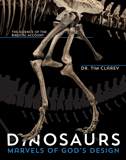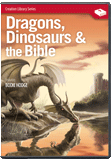
Dinosaur Demise Theory from LiveScience
A cocktail of environmental changes initiated by watery catastrophe doomed the dinosaurs, reports LiveScience on research published in Nature Geosciences.
News Source
- LiveScience: “Dinosaur Demise Theory Is Soaking Wet”
A new three-dimensional analysis of the 112 mile (180 km) wide Chicxulub Crater suggests the effects of the meteor that made it were numerous and all contributed to the dinosaur die-out an alleged 65 million years ago. The study indicates the meteor splashed into deeper water than originally assumed, which would result in the release into the atmosphere of almost seven times more water vapor than was thought. The vapor, combining with sulfur, would have produced sulfate aerosols that would have cooled the climate and triggered acid rain, also possibly making the oceans more acidic. But before then, many large animals purportedly might have been killed by the heat caused by the material ejected from the impact.
Many large animals purportedly might have been killed by the heat caused by the material ejected from the impact.
At this point, it’s useful for us to revisit the topic of the mass dinosaur extinction and the Chicxulub Crater. The dinosaur extinction is frequently tied to the K–T boundary, which lies between what are considered Cretaceous and Tertiary geological layers. A thin layer separates the K and the T, and this layer contains far more iridium than most earth rock. Since iridium is found more frequently in space, some scientists have concluded that this layer—this boundary—was deposited after a massive meteor impact, an impact so large it could have brought down the dinosaurs. When the Chicxulub Crater was discovered off Mexico’s Yucatan peninsula, it was matched up with this layer as the cause for the dinosaur demise.
There are some holes in this crater-based hypothesis, however. For one thing, old-earth dating methods of the Chicxulub Crater have produced dates around 300,000 years earlier than the K–T boundary. Although that may seem like a small difference, the iridium layer from the Chicxulub meteor should have been deposited shortly after the impact, not hundreds of thousands of years later. Also, because the earth’s core contains higher levels of iridium than the surface, volcanoes can deposit layers of iridium, and some scientists have speculated that massive volcanism was responsible for the K–T boundary.
Meteor impact is compatible with the biblical Flood model, but more likely is that the Flood itself caused a massive dose of volcanism, which deposited the iridum-rich layer worldwide (see Setting the Stage for an Ice Age). When wearing biblical lenses, the prevailing geological models of millions of years can be easily understood as the result of the Flood’s massive reworking of the earth’s surface, rather than the theoretical gymnastics of any catastrophism but that.
Further Reading
For More Information: Get Answers
Remember, if you see a news story that might merit some attention, let us know about it! (Note: if the story originates from the Associated Press, FOX News, MSNBC, the New York Times, or another major national media outlet, we will most likely have already heard about it.) And thanks to all of our readers who have submitted great news tips to us. If you didn’t catch all the latest News to Know, why not take a look to see what you’ve missed?
(Please note that links will take you directly to the source. Answers in Genesis is not responsible for content on the websites to which we refer. For more information, please see our Privacy Policy.)
Recommended Resources

Answers in Genesis is an apologetics ministry, dedicated to helping Christians defend their faith and proclaim the good news of Jesus Christ.
- Customer Service 800.778.3390
- © 2024 Answers in Genesis





